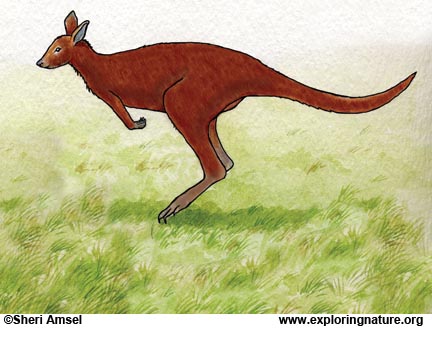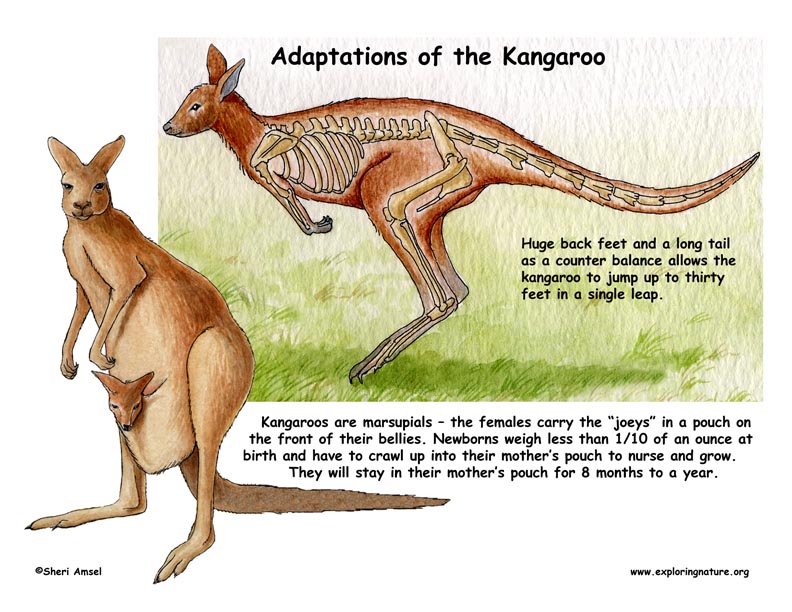

Adaptation in a population of living things happens as a result of an adaptive trait. This is any inheritable trait that increases its survival rate so that it can live longer, reproduce longer, and have more offspring (that also have that trait). Adaptive traits can improve an animal's ability to find food, make a safer home, escape predators, survive cold or heat or lack of water.
The kangaroo lives out in open country. They have a mode of travel that is perfectly adapted for this open habitat. They jump! This is called saltatory locomotion. With huge back feet and a long tail as a counter balance, kangaroos can jump up to thirty feet in a single leap. They are built to jump. Kangaroos can also move quickly from side to side. They are very agile, but they cannot jump backward because of their thick, muscular tail. Their long feet and heavy tail also make walking very difficult, forward or backward.
Kangaroos also are able to go for long periods of time without water. They can do this because their digestive tract is able to reabsorb every drop of water from the foods they eat.
Another interesting physical adaptation is that kangaroos are marsupials so the females carry the “joeys” in a pouch on the front of their abdomen (belly). Newborns weigh less than 1/10 of an ounce at birth and have to crawl up into their mother’s pouch to nurse and grow. They will stay in their mother’s pouch for 8 months to a year. All these adaptive traits (which are physical adaptations) help the kangaroo survive in the arid climate and open spaces of the Australian outback.
For Discussion and Critical Thinking:
The kangaroo has adaptive traits that helps it survive in its hot, dry, open Australian habitat.
1. Name two of the kangaroo’s adaptive traits and how it helps it survive:
2. Name two animals from your yard, local parks or wild areas (forests, prairies, wetlands, etc.) who use the same type of jumping locomotion as the kangaroo. For each explain how the animal is physically different from the kangaroo despite its jumping trait.
3. Why would the kangaroo’s physical traits not work in a forested habitat
When you research information you must cite the reference. Citing for websites is different from citing from books, magazines and periodicals. The style of citing shown here is from the MLA Style Citations (Modern Language Association).
When citing a WEBSITE the general format is as follows.
Author Last Name, First Name(s). "Title: Subtitle of Part of Web Page, if appropriate." Title: Subtitle: Section of Page if appropriate. Sponsoring/Publishing Agency, If Given. Additional significant descriptive information. Date of Electronic Publication or other Date, such as Last Updated. Day Month Year of access < URL >.
Amsel, Sheri. "Adaptations of the Kangaroo" Exploring Nature Educational Resource ©2005-2024. December 13, 2024
< http://www.exploringnature.org/db/view/Adaptations-of-the-Kangaroo >

